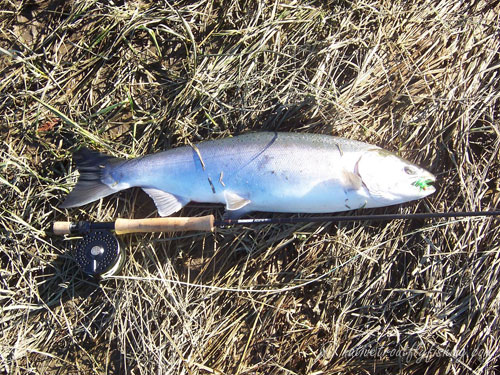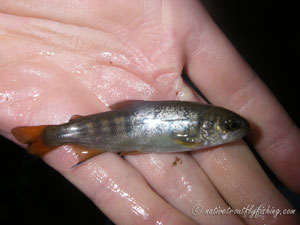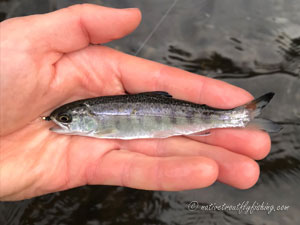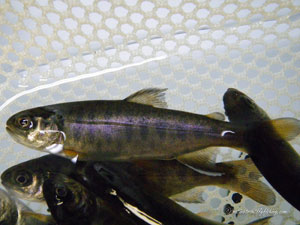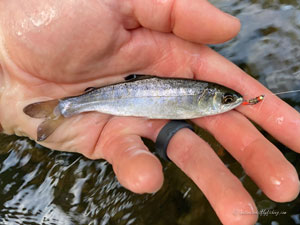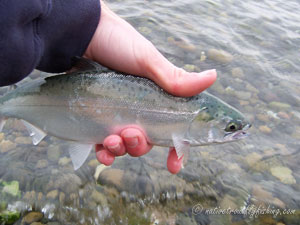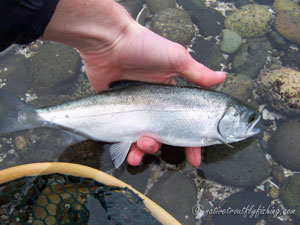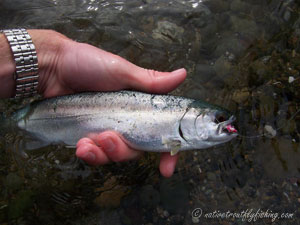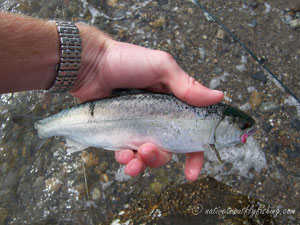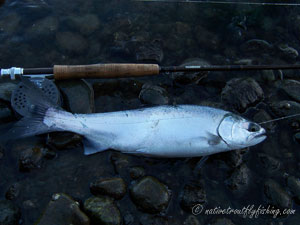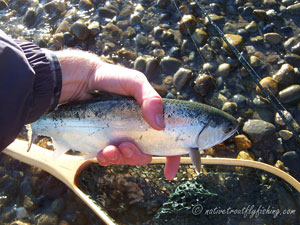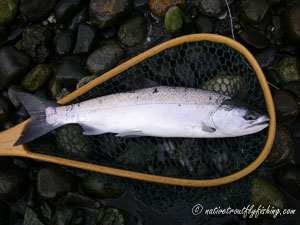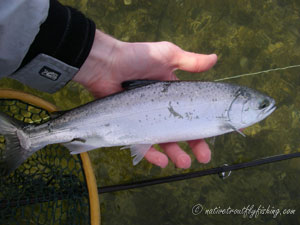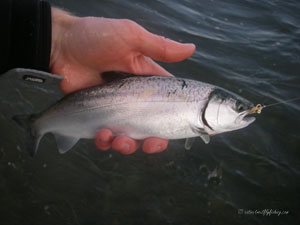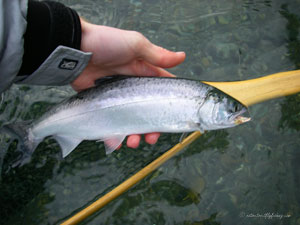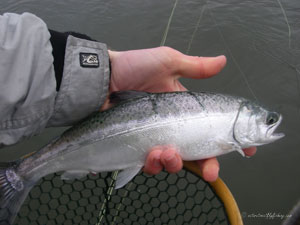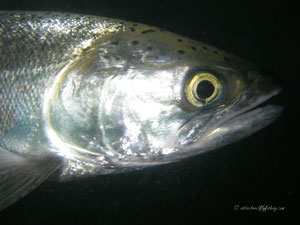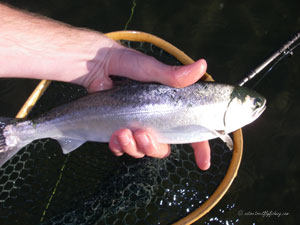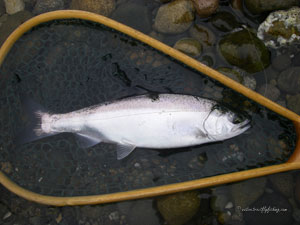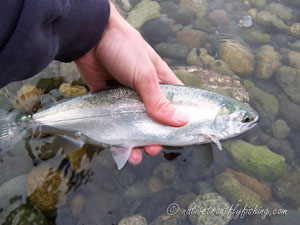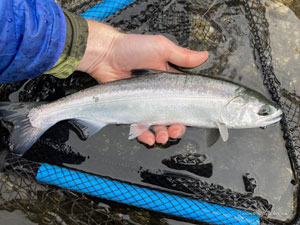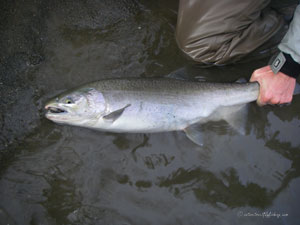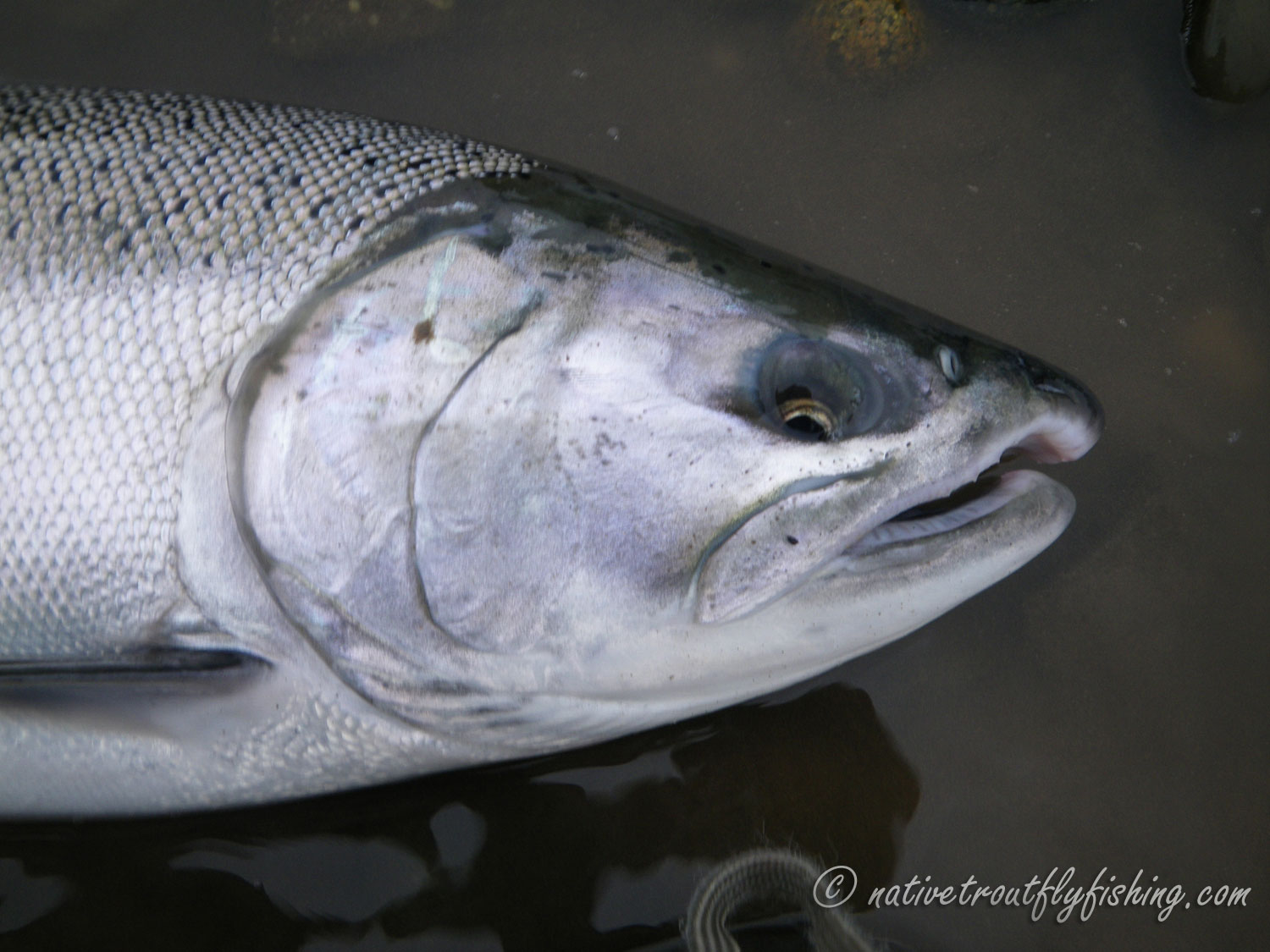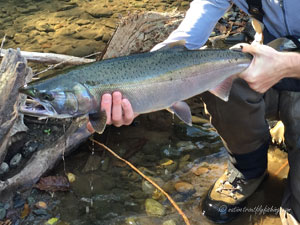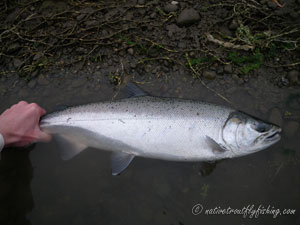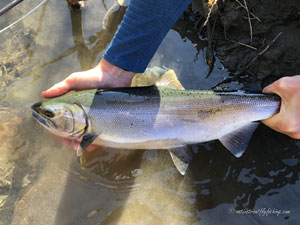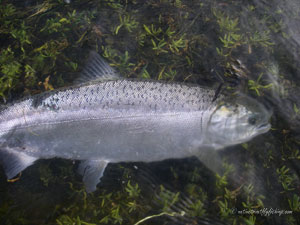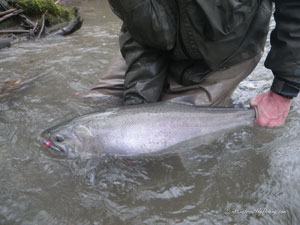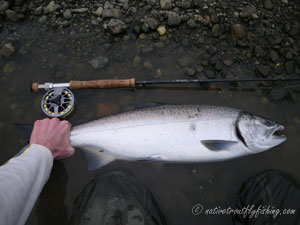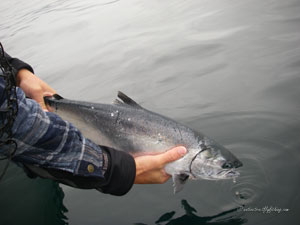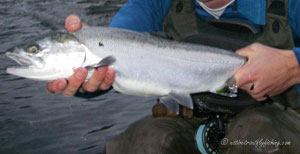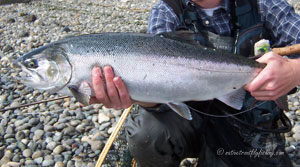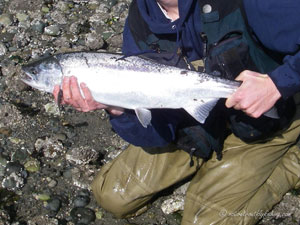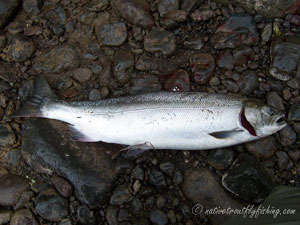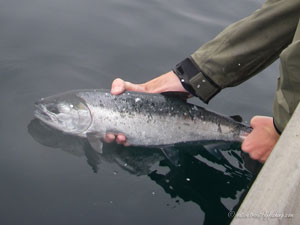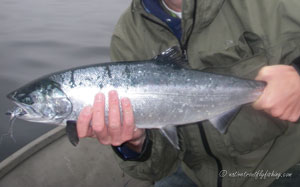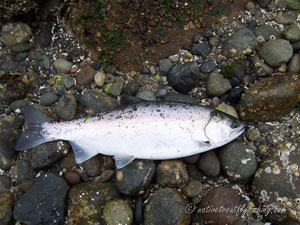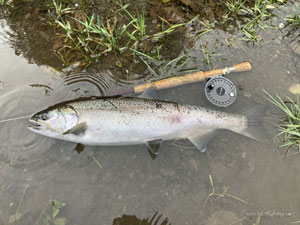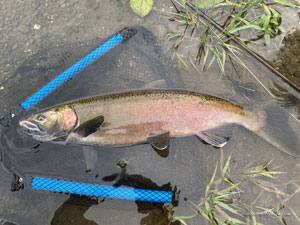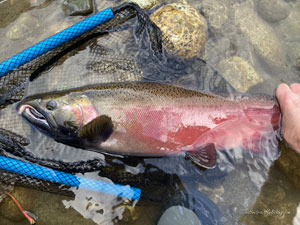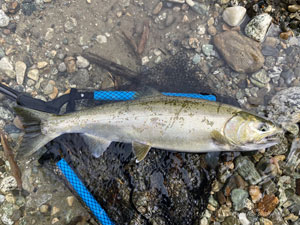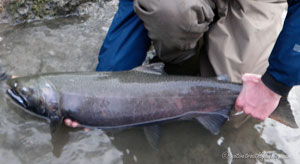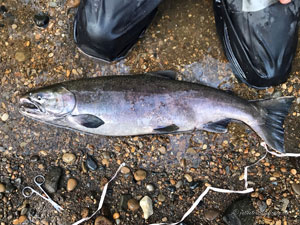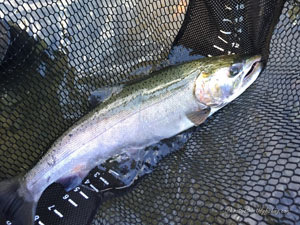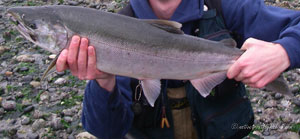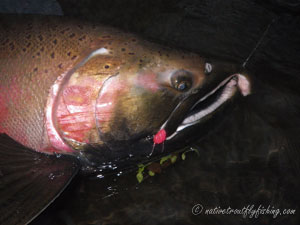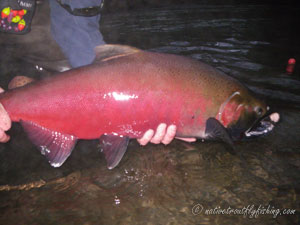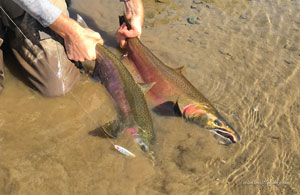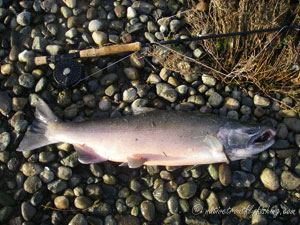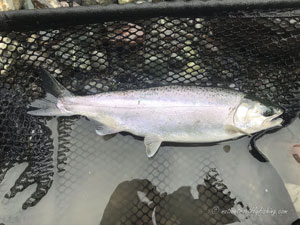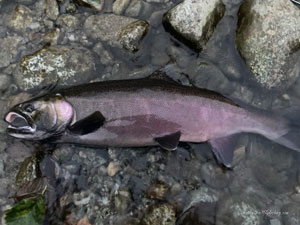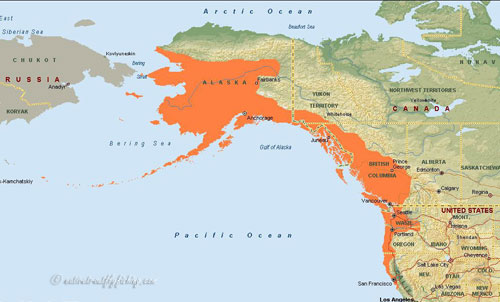Coho Salmon
Oncorhynchus kisutch
A returning ocean going female coho salmon caught in a local estuary
Introduction
Coho are the second least abundant species of Pacific salmon (Behnke 2002) and primarily spawn and rear in small to moderate sized coastal and interior streams. Coho are smaller than Chinook or chum salmon and average 6 to 9 lbs. (2.7 – 4 kg.) and 24” to 28” (61 – 71 cm) long. The native range of coho in North America extends from Scott Creek, California to Point Hope, Alaska and from Northern Japan to the Anadyr River, Russia within Asia (Wahle, R.J. and R.E. Pearson. 1987, Sandercock 1991, Augerot et al. 2005, Quinn 2005, Adams et al. 2007). Coho have also been introduced outside of their native range into the Great Lakes of the USA, where the world record coho weighing 33 lbs (15 kg) was caught. Other common names for coho include silver salmon for their bright silver coloration while at sea, and blueback salmon (primarily in Canada).
Life History Information
Like other species of Pacific salmon, coho exhibit a wide variety of life history strategies. As a general rule, coho spawning runs occur anywhere from September into November, but in some streams spawning may occur as late as February (Behnke 2002). For the most part coho only spawn in streams within 100 to 200 miles of the saltwater, although some populations do have to travel much further to reach their spawning grounds. One example of this is the coho populations of the Yakima River system in Washington, which travel 400 or more miles from the ocean to spawn. The majority of coho salmon spawning occurs in smaller sized streams and tributaries of rivers, instead of the in the main river channel like Chinook.
Coho fry usually hatch between March and April, and will generally spend one year in their natal stream before migrating out to sea. However in some populations juveniles may head out to sea the spring after they hatch or remain in their natal stream for two years. Coho smolts usually head out to the saltwater in April and May at a length of between 4 and 5 inches. However some populations of coho, such as those in Riffe Lake, WA exhibit a lacustrine like history strategy, where juveniles migrate to a lake instead of traveling to the ocean. Those coho that do exhibit the anadromous life history typically spend a short amount of time feeding in estuarine waters before heading away from their natal stream. However some may stay to spend their entire lives in these estuarine waters and this life history pattern is quite common in fish in Washington's Puget Sound. The Puget Sound "resident" coho fishery is largely maintained through hatchery supplementation and it was discovered that by holding the young coho in net pens longer than usual, it causes a large portion of them to remain in the Puget Sound. The Puget Sound resident coho will often make a mini migration north into the Strait of Juan de Fuca, but do not generally grow as large as their ocean going counterparts. Ocean going coho generally feed in the coastal waters off of the continental shelf, and have a tendency to travel north of their natal streams toward the Gulf of Alaska, although some do travel south toward California. While at sea coho feed mostly on euphausids, squid and fish, feeding the second highest on the food chain after Chinook salmon (Quinn 2005). Generally speaking coho and Chinook travel slower than other salmon on their migration from their feeding grounds to their natal stream, often feeding heavily along the way. Most coho return to spawn after two years at sea (3-4 years of age), although some males; referred to as "Jacks" are known to return after a single summer of feeding in marine waters.
Status
As with the other species of Pacific salmon, coho populations have severely declined across their native range since the arrival of European Americans on the west coast. Today out of the seven ESU populations of coho that have been identified by NOAA in Washington, Oregon and California, one is currently listed as endangered, and two are listed as threatened (NOAA 2007). Like the other species of salmon, there is a slew of factors that are contributing to the decline of their populations (4 H's) with two of the major ones being habitat destruction and hatchery fish. The improper use artificial propagation has been a long standing problem in fisheries management. This is a major problem facing coho and other salmon populations and dates back to when the original brood stocks of hatchery salmon were established. At that time local adaptations were not taken into account and hatchery stocks were often mixed and/ or brought in from out of state. When these hatchery fish return and spawn with native fish it leads to a loss of genetic adaptations to the local environment. Another problem with hatchery fish has to do with competition with native fish. When the hatchery fish are released, they are generally larger than the native fish making them better competitors for food and territory (Lichatowich 1999). Beyond this due the fact that the hatchery fish are raised in confined areas (raceways and holding ponds) with many other fish, they tend to be bolder also giving them a competitive edge.
Logging and urbanization have been especially harmful to coho due to the habitat destruction associated with them. The loss of riparian vegetation from logging leads to warmer water temperaturesand lower summer time flows, which can be a lethal combination for juvenile salmon. Due to the loss of forested lands and increase in paved land in areas with urbanization and logging, the effects and magnitude flooding and run off events are greatly increased. This in turn leads to an increase in scour and erosion causing more silt to enter the streams. This increase in siltation can be deadly to incubating salmon eggs by cutting off their air supply. These are just a couple of the issues in the long list of problems facing coho salmon, and salmon in general for that matter making it no big surprise that coho stocks around the Pacific Northwest are depressed.
Description
Coho salmon tend to be somewhat similar to Chinook in appearance, but do have a few distinguishing traits. The first way to tell these fish apart is that Chinook have black gums where as coho salmon have gray or white gums. Also Chinook salmon have spots across their entire caudal fin, but coho generally only have a few spots that are concentrated on just the upper half of the fin. The coloration juvenile coho is generally olive to greenish-brown with silvery sides, and eight to ten oval shaped parr marks that are skinnier than the spaces in between the markings. Juvenile coho have white border by black front leading edged on both their dorsal and anal fins, and their anal fin tends to be more curved than in other species of Pacific salmon. It is believe that these markings on their fins are used in settling territorial disputes. Coho typically display small irregular shaped spots above the lateral line and while in the saltwater these fish have a bright silver coloration, with bluish-green to greenish-brown backs. As spawning approaches, coho take on a dull greenish-brown to rosy or maroon color. Like other species of Pacific salmon the spawning morphology of male coho tends to be more extreme than that of the females. When spawning approaches the males obtain small hump in front of their dorsal fin, as well as a pronounced kype, which has led to the nickname of "hook nose" for late season male coho.
Fly Fishing Information
Coho salmon have long been very popular with fly fisherman, due to their willingness to hit flies and their hard fighting nature. When coho are intercepted in the ocean or in waters some distance from their natal streams, they will often hit flies with reckless abandon. However once coho near their home estuary they can become very difficult to catch due to the physiological changes associated with spawning. In Washington it is not unusual to find good numbers of coho staging off of estuaries that refuse any offering an angler throws at them. However at other times these "lock jawed" fish in the Puget Sound will take flies very willingly, and it is often just a matter of changing flies and retrieves until it can be determined what the fish are looking for. One life history form of coho that provides a particular appeal for fly fisherman in the Puget Sound region is known as the "resident coho". These fish can be caught from shore during any time of the year in the Puget Sound although fishing tends to be best during the winter and spring. Resident coho usually are not very large, averaging around 12" - 16", with some larger fish around making them great fish to target with a six weight rod. When adult ocean going coho arrive in the rivers, they are generally best targeted with a 7 or 8 weight rod and are usually receptive of flies in pink, orange, and chartreuse with a bit of flash.
Coho Parr - Pre-smolt stage
Click on images to view a larger picture
Estuarine Resident
Contact
Feel free to contact me if you have any questions or comments
Native Trout Links
California Heritage Trout Challenge
Truchas Mexicanas' - Native Trout of Mexico
Balkan Trout Restoration Group
Trout and Seasons of the Mountain Village - About Japanese Trout
Fly Fishing Blogs
Dave B's Blog: Fly Fishing for Native Trout
The Search for Native Salmonids
Conservation Links
Western Native Trout Initiative
Fly Fishing Links
Fishing Art Links
Americanfishes.com - Joseph R. Tomelleri
